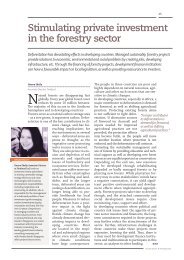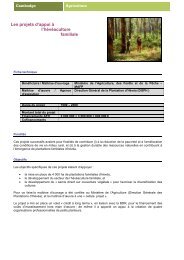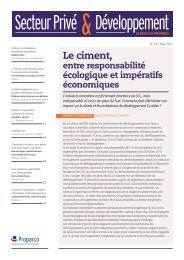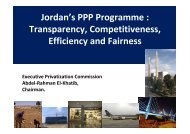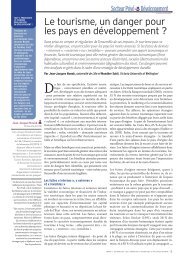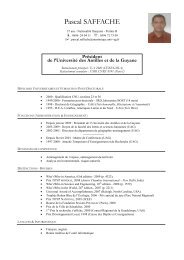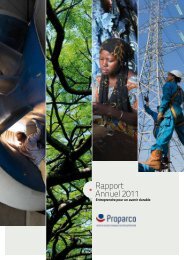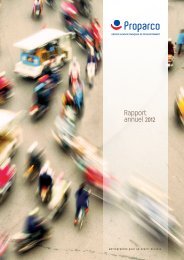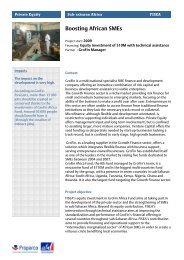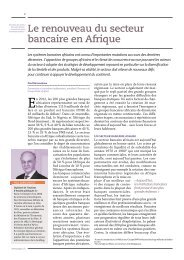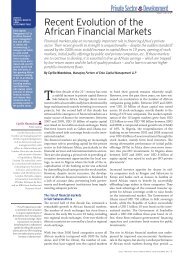Integrating Poor Populations in South African Cities - Agence ...
Integrating Poor Populations in South African Cities - Agence ...
Integrating Poor Populations in South African Cities - Agence ...
You also want an ePaper? Increase the reach of your titles
YUMPU automatically turns print PDFs into web optimized ePapers that Google loves.
1. An Urban History of <strong>South</strong> Africa: From 1652 to the Present<br />
<strong>in</strong>itiatives 19 emerged and were progressively acknowledged by the Department of<br />
Hous<strong>in</strong>g that took the <strong>in</strong>itiatives <strong>in</strong>to account by slightly amend<strong>in</strong>g the Hous<strong>in</strong>g Act. This<br />
public assistance system, still largely <strong>in</strong> force today, will be presented <strong>in</strong> greater detail<br />
<strong>in</strong> Part Three.<br />
1.2.4. Very Positive Quantitative Results but Qualitative Limitations Demanded<br />
a New Direction<br />
This hous<strong>in</strong>g policy, which began <strong>in</strong> 1994 and endeavoured to produce a large<br />
number of houses for private ownership very rapidly, made it possible to provide homes<br />
to poor people <strong>in</strong> a remarkable way. Indeed, the government of <strong>South</strong> Africa spent 29.5<br />
billion rand 20 <strong>in</strong> ten years and enabled the construction of 1.6 million RDP houses.<br />
This system made it possible to house thousands of families and automatically ensured<br />
access to essential utilities (water and electricity). This policy was developed <strong>in</strong> response<br />
to the urgency of the situation, and it can be compared to the “politique des grand<br />
ensembles” (large ensembles policy) elaborated <strong>in</strong> France at the end of the 1950s. In<br />
response to the rural exodus and the major urbanization phase, the French government<br />
developed centralized measures to produce decent hous<strong>in</strong>g for urban workers very<br />
rapidly and <strong>in</strong>expensively. These measures led to the construction of outly<strong>in</strong>g, purely<br />
residential neighbourhoods, large towers and build<strong>in</strong>gs conta<strong>in</strong><strong>in</strong>g social hous<strong>in</strong>g units.<br />
Thus, faced with the need to take rapid action and house people <strong>in</strong> acceptable<br />
sanitary conditions, <strong>South</strong> Africa created these RDP houses. However, despite laudable<br />
quantitative results, limits were reached. First, <strong>in</strong> order to allow a maximum of households<br />
to receive the subsidy, the amount granted was small: this brought about<br />
standardization and poor architectural quality for houses. In addition, <strong>in</strong> order to<br />
reduce costs, the promoters wanted to build homes on the large scale and on<br />
outly<strong>in</strong>g tracts of land. This policy of provid<strong>in</strong>g RDP houses was rapidly criticized and<br />
its approach was seen as too liberal. 21 Indeed, the government was supposed to have<br />
a facilitat<strong>in</strong>g role, and the provision of hous<strong>in</strong>g was concretely carried by the private<br />
45<br />
19. Primarily <strong>in</strong>itiatives by NGOs that seek to mitigate the uniformity of the public hous<strong>in</strong>g policy.<br />
20. 29.5 billion rand = 2.3 billion euros.<br />
21. Hous<strong>in</strong>g assistance was <strong>in</strong>itially supposed to make up 5% of the total state budget but was <strong>in</strong> fact reduced<br />
to 1.4%.<br />
© AFD 2009 <strong>Integrat<strong>in</strong>g</strong> <strong>Poor</strong> <strong>Populations</strong> <strong>in</strong> <strong>South</strong> <strong>African</strong> <strong>Cities</strong>



